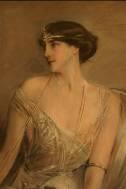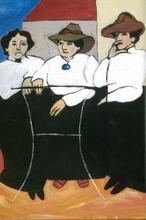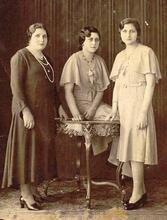Linda Rosenberg Miller
Unsatisfied with the traditional pursuits of married women of her day, Linda Rosenberg Miller devoted herself to Jewish studies and collecting art and archeological treasures. At age 21 she married Nathan Miller and settled in New York to raise her family. She financed the donation of Rabbi Hyman G. Enelow’s massive collection of rare books to the Jewish Theological Seminary and endowed a foundation at Columbia University that made Salo Baron the university’s first professor of Jewish history. She also paid for the publication of Israel Davidson’s Thesaurus of Mediaeval Poetry and his Gaonic commentary on the Talmud, both of which incorporated genizah discoveries that changed the scholarly understanding of the development of Jewish thought.
Early Life
Linda Rosenberg Miller was a patron of the arts and Jewish scholarship.
She was born in 1877 in Wheeling, West Virginia, the youngest of four daughters. Her mother, whose maiden name was Kraft, was Bavarian but lived her adult life in Wheeling. She died when Linda was eleven years old, and her older sister Clemmie was responsible for her upbringing.
Her father, Victor Rosenberg, was born in the United States. He worked in his family’s wholesale notions and dry goods business for more than thirty years. A civic leader and devoted father, he died when Linda was seventeen. During his year of illness, Linda put aside her regular teenage activities in order to care for him.
Miller was the valedictorian of her high school class and attended the Washington, Pennsylvania, Female Seminary. After completing her studies, she moved to Baltimore, Maryland, where two of her three sisters had married and settled. There she married Nathan J. Miller, who had recently graduated from Johns Hopkins University. Nathan Miller began a financial career in Baltimore, and he and his twenty-year-old bride settled there.
The Millers later moved to New York and had two daughters, Helen and Peggy. Although her husband was involved with the community, Miller did not enjoy life in New York. She, along with her sister Rose Kraus, rented summer cabins in Rangely Lake, Maine, where they took their children. They were pioneers among Jewish women who took long vacations in remote places, away from their husbands.
Philanthropic Work
Miller was not drawn to traditional charity work. She was more attracted to spiritual and artistic activities. She became friends with Rebecca Mahler, who introduced her to the world of art. She bought works by Mahler and they spent time together at art shows in New York. She became a serious collector, purchasing works by Cézanne, Derain, and Matisse. In her world travels, she collected art and artifacts from India and Egypt.
Miller became an active member of Temple Emanu-el and a great supporter of its rabbi, Hyman G. Enelow. Miller attended his lectures at the temple, heard his weekly sermons, and he taught her at home.
Misfortune struck the Miller family when Nathan Miller’s business failed, followed by his death two years later. Miller then moved to New Rochelle, New York, where she lived in seclusion for the rest of her life. Her intellectual and spiritual pursuits flourished. She learned French and studied Hebrew with Rabbi Joseph Marcus in order to be able to study the Bible and prayer book in the original. She studied the Codification of basic Jewish Oral Law; edited and arranged by R. Judah ha-Nasi c. 200 C.E.Mishnah, as well as works by Judah Halevi and Solomon ibn Gabirol. Miller was also actively involved in the Jewish education of her grandchildren, particularly after the tragic death of her daughter Peggy at age twenty-nine.
Linda Rosenberg Miller died on July 26, 1936, in New Rochelle, New York. Her legacy financed the donation of Rabbi Hyman G. Enelow’s collection of rare books and manuscripts to the Library of the Jewish Theological Seminary of America. The collection contains 20,000 volumes, including 1,100 manuscripts. She endowed a foundation at Columbia University devoted to Jewish history and literature that brought Salo Baron to Columbia as the first professor of Jewish history in the United States. She also financed the publication of Israel Davidson’s Thesaurus of Mediaeval Poetry, and supported the publication on Gaonic commentary of the Lit. "teaching," "study," or "learning." A compilation of the commentary and discussions of the amora'im on the Mishnah. When not specified, "Talmud" refers to the Babylonian Talmud.Talmud, and assisted in and supported the publication of the Hebrew weekly and annual of the Histradrut Ivrith in the United States. Notwithstanding the difficulties and tragedies that Miller encountered in the final years of her life, she was a resilient, dedicated, loyal, and spiritual woman who served as a role model for future generations.
AJYB 39:594.
Essays and Studies in Memory of Linda R. Miller. Edited by Israel Davidson (1938).
Great Books from Great Collections (1996).
Hurwitz, Ruth Sapin. “Linda R. Miller: A Memoir.” The Menorah Journal 25, no. 3 (Autumn 1937): 352–363.
Levy, Felix A. Selected Works of Hyman G. Enelow: A Memoir. Vol. 1 (1935).
UJE, s.v. “Miller, Nathan J.”








